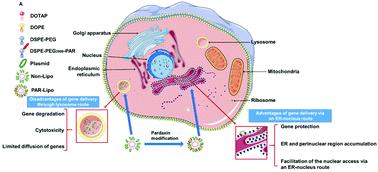Our official English website, www.x-mol.net, welcomes your feedback! (Note: you will need to create a separate account there.)
Targeting DNA to the endoplasmic reticulum efficiently enhances gene delivery and therapy.
Nanoscale ( IF 6.7 ) Pub Date : 2020-08-07 , DOI: 10.1039/d0nr03156a Bing Qin 1 , Xiaoling Yuan , Mengshi Jiang , Hang Yin , Zhenyu Luo , Junlei Zhang , Chunqi Zhu , Xiang Li , Yingying Shi , Lihua Luo , Yongzhong Du , Jian You
Nanoscale ( IF 6.7 ) Pub Date : 2020-08-07 , DOI: 10.1039/d0nr03156a Bing Qin 1 , Xiaoling Yuan , Mengshi Jiang , Hang Yin , Zhenyu Luo , Junlei Zhang , Chunqi Zhu , Xiang Li , Yingying Shi , Lihua Luo , Yongzhong Du , Jian You
Affiliation

|
Gene therapy mediated by non-viral carriers is gaining an increasing popularity due to its high biosafety and the convenience of production on a large scale, yet inefficient gene delivery is a limiting obstacle. Few gene vectors can avoid the endosome–lysosome route, and as a result, their DNA payloads are easily decomposed during transfection. Herein, a peptide (pardaxin, PAR)-modified cationic liposome (PAR-Lipo) targeting the endoplasmic reticulum (ER) was developed for improving the gene delivery efficiency. Interestingly, compared to non-PAR-modified cationic liposomes (Non-Lipos) and Lipofectamine 2000 (Lipo 2000, a commercial genetic vector), PAR-Lipos showed remarkably higher gene delivery efficiency in vitro and better antitumor efficacy in vivo. It was demonstrated that PAR-Lipos could be accumulated into the ER via a non-lysosome intracellular route after cellular internalization, which induced the retention of the DNA payload in the ER close to the nucleus, while Non-Lipos, like most conventional cationic carriers, mainly presented lysosomal retention after their endocytosis. The unique intracellular transport behavior of PAR-Lipos can enhance the protection of the DNA payload, prolong their residence time in the cell, and promote their entry into the nucleus relying on the intimate relationship between the ER and nuclear membrane, which is the explanation for the enhanced gene-therapy effect mediated by PAR-Lipos. Our research may provide alternative means of efficiently delivering genes in cells.
中文翻译:

将DNA靶向内质网可有效增强基因的传递和治疗。
由于非病毒载体的高生物安全性和大规模生产的便利性,由非病毒载体介导的基因治疗正越来越受到人们的欢迎,但基因传递效率低是一个限制因素。很少有基因载体能够避免内体-溶酶体途径,因此,其DNA负载在转染过程中容易分解。在本文中,开发了靶向内质网(ER)的肽(pardaxin,PAR)修饰的阳离子脂质体(PAR-Lipo),以提高基因传递效率。有趣的是,与非PAR修饰的阳离子脂质体(Non-Lipos)和Lipofectamine 2000(Lipo 2000,商业遗传载体)相比,PAR-Lipos在体外的基因传递效率显着提高,在体内具有更好的抗肿瘤功效。已经证明,PAR-Lipos可以在细胞内化后通过非溶酶体细胞内途径积累到ER中,从而诱导DNA负载保留在靠近细胞核的ER中,而Non-Lipos像大多数常规阳离子载体一样,主要表现为内吞后溶酶体保留。PAR-Lipos独特的细胞内运输行为可以增强对DNA有效负载的保护,延长它们在细胞中的停留时间,并依靠ER与核膜之间的密切关系促进它们进入核内,这是对PAR-Lipos介导的增强的基因治疗效果。我们的研究可能提供有效地在细胞中传递基因的替代方法。
更新日期:2020-09-18
中文翻译:

将DNA靶向内质网可有效增强基因的传递和治疗。
由于非病毒载体的高生物安全性和大规模生产的便利性,由非病毒载体介导的基因治疗正越来越受到人们的欢迎,但基因传递效率低是一个限制因素。很少有基因载体能够避免内体-溶酶体途径,因此,其DNA负载在转染过程中容易分解。在本文中,开发了靶向内质网(ER)的肽(pardaxin,PAR)修饰的阳离子脂质体(PAR-Lipo),以提高基因传递效率。有趣的是,与非PAR修饰的阳离子脂质体(Non-Lipos)和Lipofectamine 2000(Lipo 2000,商业遗传载体)相比,PAR-Lipos在体外的基因传递效率显着提高,在体内具有更好的抗肿瘤功效。已经证明,PAR-Lipos可以在细胞内化后通过非溶酶体细胞内途径积累到ER中,从而诱导DNA负载保留在靠近细胞核的ER中,而Non-Lipos像大多数常规阳离子载体一样,主要表现为内吞后溶酶体保留。PAR-Lipos独特的细胞内运输行为可以增强对DNA有效负载的保护,延长它们在细胞中的停留时间,并依靠ER与核膜之间的密切关系促进它们进入核内,这是对PAR-Lipos介导的增强的基因治疗效果。我们的研究可能提供有效地在细胞中传递基因的替代方法。


























 京公网安备 11010802027423号
京公网安备 11010802027423号